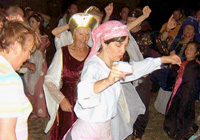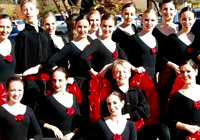Spanish dance history
The concept of Spanish dance immediately conjures up images of the strumming guitars, stomping feet and bright dresses of flamenco. While many people make this common connection between Spain and flamenco, a plethora of traditional dances from Spain's various regions weave into the lengthy history of Spanish dance. For example, not many people would ever expect to visit Spain and hear the music of bagpipes and tambourines floating through the air, yet it is the traditional music accompanying Spanish dance across northern Spain!


For almost as long as man has existed he has used dance as a form of communication and personal expression. Spain is certainly no exception. Ritualistic dances commemorating battles and other war-related themes were the first to appear, and centuries later during the Middle Ages, structured religious-themed ritual dances were recognizable.
The 15th century saw the distinction created between the various genres. Serious and measured dances quickly grew outdated while the popularity of the happier and free-moving dances surged exponentially. With the Renaissance, popular and folk dance continued to make huge strides in the history of Spanish dance and even gained recognition internationally. These regional dances both flourished on their own and melded with other dances to birth brand new ones. You can imagine how many- at one point, there were over 200 traditional dances in the region of Catalonia alone!
During the Baroque period, gypsies arrived to the Iberian continent and the growing popularity of the gypsy music and dance, flamenco, eagerly formed part of the history of Spanish dance. The rest is history- or rather Spanish dance history- as flamenco has since become both a national and international sensation. With feisty flamenco's ever-rising fame, regional dances suffered a decline- a decline which intensified during the 20th century, when the dictator Francisco Franco actually banned all things regional, including dance, music, and languages. Luckily today there has once again been a boost in the pride and the practice of traditional dances, and the history of Spanish dance continues!
Traditional Spanish Dances
Jota Aragonesa. This typical dance hails from the north of Spain, namely Aragón, and features a fast tempo as couples dance with their hands raised high above their heads playing castanets.
Sardana. Several couples join hands and dance in a closed circle in this traditional dance from Catalonia.
Muñeira. Danced in twos or alone along to the music of bagpipes, this traditional "Miller's Dance" is typical throughout Galicia and Asturias.
Zambra. The zambra began as a Moorish dance, but with monarchs Fernando and Isabel's reconquista of Spain, the Moors were able to conserve the dance by adapting it to Spanish dance customs.
Bolero. One of the oldest and most traditional dances of the history of Spanish dance, the bolero is a quick Spanish dance boasting sudden pauses and sharp turns.
Fandango. At one point the most famous dance of Spain, the fandango is a lively, happy Spanish danced in two's.
Pasodoble. A quick one-step Spanish dance.
Flamenco. A passionate dance hailing from gypsies, flamenco is internationally famous. Learn more!
Sevillana. Lively and joyous dance typical of Seville and reminiscent of flamenco that features four distinct parts.




